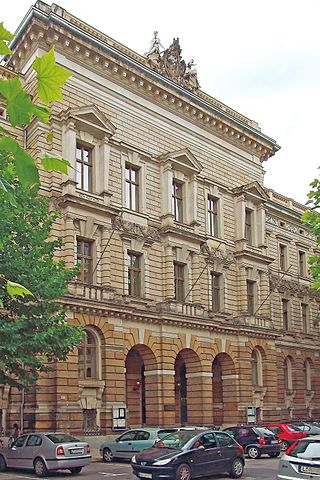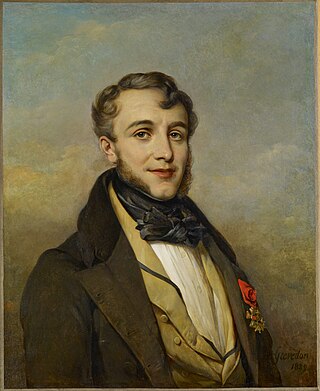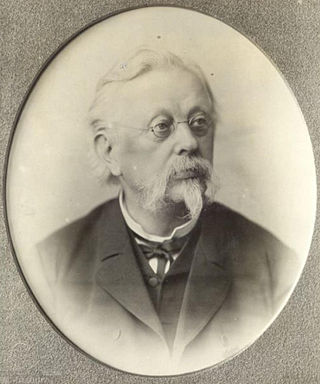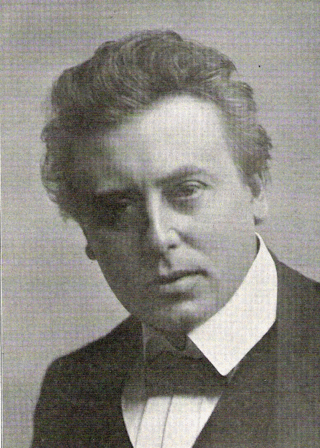
Niels Wilhelm Gade was a Danish composer, conductor, violinist, organist and teacher. Together with Johan Peter Emilius Hartmann, he was the leading Danish musician of his day, in the period known as the Danish Golden Age.

The Royal Conservatory of Music, branded as The Royal Conservatory, is a non-profit music education institution and performance venue headquartered in Toronto, Ontario, Canada. It was founded in 1886 by Edward Fisher as The Toronto Conservatory of Music. In 1947, King George VI incorporated the organization through royal charter. Its Toronto home was designated a National Historic Site of Canada in 1995, in recognition of the institution's influence on music education in Canada. Tim Price is the current Chair of the Board, and Peter Simon is the President.

The N. A. Rimsky-Korsakov Saint Petersburg State Conservatory is a school of music in Saint Petersburg, Russia. In 2004, the conservatory had around 275 faculty members and 1,400 students.

The Moscow Conservatory, also officially Moscow State Tchaikovsky Conservatory is a musical educational institution located in Moscow, Russia. It grants undergraduate and graduate degrees in musical performance and musical research. The conservatory offers various degrees including Bachelor of Music Performance, Master of Music and PhD in research.

The Peabody Institute of the Johns Hopkins University is a private music and dance conservatory and preparatory school in Baltimore, Maryland. Founded in 1857 and affiliated with Johns Hopkins in 1977, Peabody is the oldest conservatory in the United States and one of the world's most highly-regarded performing arts schools.

The University of Music and Theatre "Felix Mendelssohn Bartholdy" Leipzig (German: Hochschule für Musik und Theater "Felix Mendelssohn Bartholdy" Leipzig) is a public university in Leipzig (Saxony, Germany). Founded in 1843 by Felix Mendelssohn as the Conservatorium der Musik (Conservatory of Music), it is the oldest university school of music in Germany.

Friedrich Wilhelm Michael Kalkbrenner, also known as Frédéric Kalkbrenner, was a pianist, composer, piano teacher and piano manufacturer. German by birth, Kalkbrenner studied at the Conservatoire de Paris, starting at a young age and eventually settled in Paris, where he lived until his death in 1849. Kalkbrenner composed more than 200 piano works, as well as many piano concertos and operas.

Rudolf Tobias was the first Estonian professional composer, as well as a professional organist. He studied at the Saint Petersburg Conservatory. His compositions include among others piano works, string quartets and an oratorio, Des Jona Sendung.
Balys Dvarionas, was a Soviet and Lithuanian composer, pianist, conductor and educator. Dvarionas first became known as a composer after World War II. His works are in a romantic vein, with roots in folk song.

Wilhelm Rust was a German musicologist and composer. He is most noted today for his substantial contributions to the Bach Gesellschaft edition of the works of Johann Sebastian Bach.

Louis Christian August Glass was a Danish composer.
Pietro Abbà Cornaglia was an Italian organist, concert pianist, and composer.
Jørgen Ditleff Bondesen was a Danish composer and music theorist.
Carl Cohn Haste was a Danish pianist, organist and composer. Blind from the age of 5 after an eye inflammation, he became a music teacher at the Royal Blind Institute, composer and the first president of the Danish Association of the Blind.

Edouard Charles Louis Dethier was a Belgian classical violinist and teacher. He was a soloist with the New York Philharmonic and New York Symphony orchestras as well as extensively touring the United States and Canada as a recitalist. From 1906, he also taught violin at the Juilliard School. Amongst his many distinguished pupils there was Robert Mann. He was the brother of Gaston Dethier, a noted organist and pianist, and likewise a teacher at Juilliard for many years.
William Henry Hewlett was a Canadian organist, conductor, composer, and music educator of English birth.
Joseph Humfrey Anger was a Canadian organist, pianist, conductor, composer, and music educator of English birth. His compositional output consists mainly of church music and works for solo piano and organ. Some of his more well known works are A Concert Overture for organ (1895), the patriotic song Hail Canada (1911), and Tintamarre, Morceau de Salon (1911), all of which were published by Whaley, Royce & Co. The latter piece was notably the first published classical composition to thoroughly integrate true tone clusters. He also wrote the textbooks Form in Music and A Treatise on Harmony, both of which were widely used in music schools in North America.

Gaston Marie Dethier was an American organist, pianist, and composer of Belgian birth.

The Brno Conservatory, also Brno Conservatoire, was established in Brno on 25 September 1919 by Moravian composer Leoš Janáček.
The Faculty of Music at the University of Toronto is one of several professional faculties at the University of Toronto. The Faculty of Music is located at the Edward Johnson Building, just south of the Royal Ontario Museum and north of Queen's Park, west of Museum Subway Station. MacMillan Theatre and Walter Hall are located in the Edward Johnson Building. The Faculty of Music South building contains rehearsal rooms and offices, and the Upper Jazz Studio performance space is located at 90 Wellesley Street West. In January 2021, the Faculty announced Dr. Ellie Hisama as the new Dean starting July 1, 2021.












